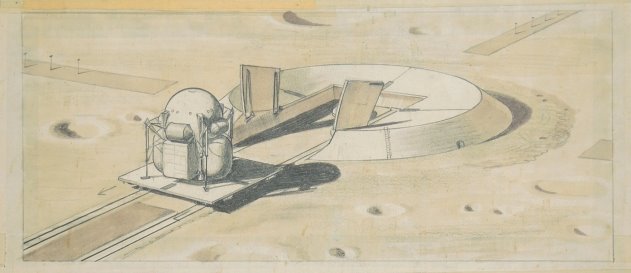New Exhibit Reveals Team Behind ‘2001: A Space Odyssey’
“To the Moon and Beyond: Graphic Films and the Inception of 2001: A Space Odyssey” is an exhibition featuring detailed sketches for 2001: Space Odyssey.
March 9, 2016
The Museum of the Moving Image launches “To the Moon and Beyond: Graphic Films and the Inception of 2001: A Space Odyssey,” an exhibit that deepens one’s appreciation for the great film even as it neatly dispels certain beliefs about it. “2001: A Space Odyssey” is one of the ultimate auteur films, springing from Stanley Kubrick’s genius mind. Here, we learn about the people who helped bring this vision into being, reminding us that not even the most personal film is a one-man show.
The exhibit is devoted to the contribution from Graphic Films, a company that designed technology for science fiction films. Kubrick first heard of them after viewing “To the Moon and Beyond,” a short film the company made for the 1965 World’s Fair in Queens. Led by former Disney animator Lester Novros, they were hired by Kubrick to provide sketches and advice for the elaborate production of “2001.” The exhibit features letters and sketches the team sent to Kubrick, as well as from “To the Moon and Beyond.”
The sketches themselves are fairly simple, resembling architectural blueprints. The simplicity provides a sense of how many stages of development it took to reach the final product. To think that these drawings, only slightly more detailed than “New Yorker” cartoons, laid the groundwork for one of the great feats in film history, is impressive.
The most interesting part of the exhibit is the letters written between Graphic Films and Kubrick. In them are discussions over every minute detail about how to represent space travel in the most beautiful and realistic way. The design team mentions meeting with NASA to get a sense of what the newest technology would look like. They warn Kubrick of how dated the film will look if it does not just match the best tech of its day, but surpass it by many years. These letters assume a heroic quality when read in retrospect. If the team had not insisted on this type of meticulous detail, everything else that is great in the film would be weighed down by a basic falseness.
In comparison, the actual “To the Moon and Beyond” short film seems fairly unimpressive now. It shows outer space in a way that is only a few steps beyond the opening sequence to “Star Trek.” However, “To The Moon and Beyond” was groundbreaking for its time. This was a time when sci-fi was mostly over the top and silly. The fact that the crew of the superfluous “To the Moon and Beyond” was the same crew behind “2001” makes it seem that sci-fi’s comical stage was a necessary stepping stone.
As a whole, the exhibit creates a sense of the development of an idea from beginning to middle. Though, not as comprehensive as the many books devoted to the film, it does a good job of giving credit to a team that deserves plenty.
“To The Moon and Beyond: Graphic Films and the Inception of 2001: A Space Odyssey” is on display at the Museum of the Moving Image now until Aug. 14.
Email Tony Schwab at [email protected].
























































































































































